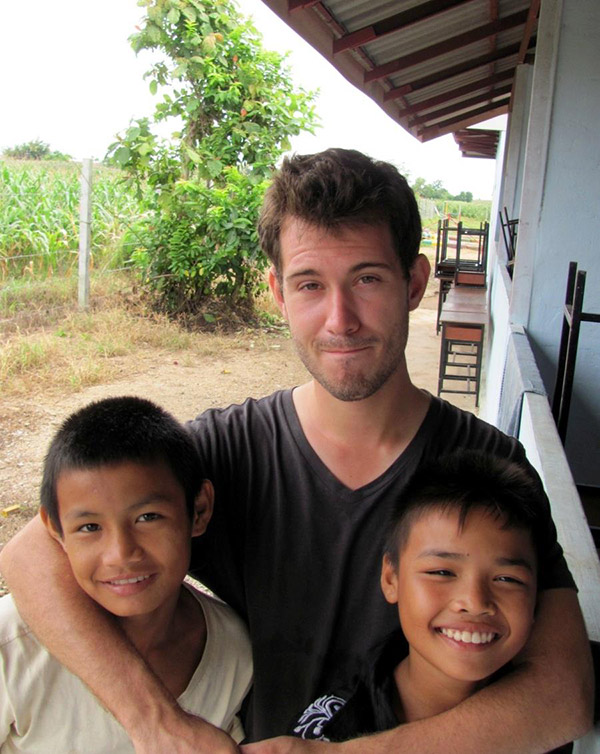 It’s recruitment time!
It’s recruitment time!
MSEP is looking for volunteers for the coming year.
Bishop’s University and Champlain College students: Change your life! Commit! Sometimes life calls upon you to embrace a deep and rich experience of service in the world beyond tourism. Take a chance on a unique overseas volunteer opportunity.
Apply NOW – Application deadline: Nov. 8th
Come to an info meeting:
Tuesday, September 24, 2019
12:30 PM for Champlain students in Champlain 360
7:00 PM for Bishop’s students in Hamilton 300
Project Developments and Opportunities
A new opportunity for Bishop’s Volunteers
MSEP volunteers have the opportunity not only to work with Burmese children but also to assist community-based organizations working in the migrant community in Mae Sot. Already in recent years our volunteers have assisted the BMWEC or Burmese Migrant Workers Education Committee by visiting and reporting on developments at schools as well as helping the organization draft funding applications. In the coming year, volunteers with special interest in this kind of international development work will be linked up with an organization.
In addition, we are collaborating with Professor David Webster at Bishop’s who is developing a 6 credit course for students who would like to combine research interests with volunteering. MSEP is prepared to keep a place this year for a student who would like to pursue this avenue for participation. Interested students should contact Prof. Webster (dwebster@ubishops.ca) to explore possibilities with him.
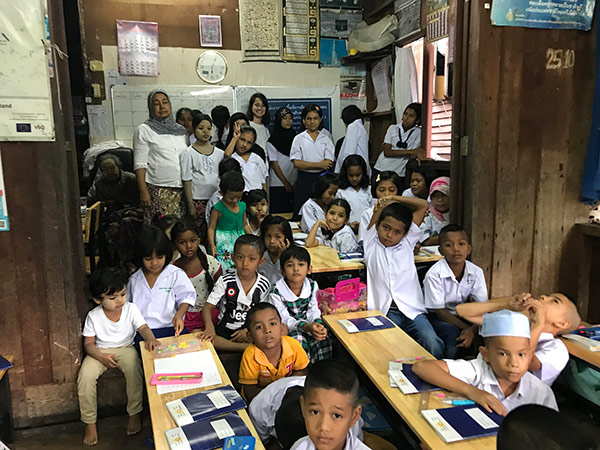
MSEP Volunteer visiting a migrant school for BMWEC reporting
Maung Maung Tinn, Artist and Friend
 Mae Sot has provided us with wonderful opportunities to develop friendships with Burmese artists who have lived the experience of forced displacement and used their work to share this experience with the wider world. Through them we have learned much about the hardships the people of Myanmar have faced over the last decades.
Mae Sot has provided us with wonderful opportunities to develop friendships with Burmese artists who have lived the experience of forced displacement and used their work to share this experience with the wider world. Through them we have learned much about the hardships the people of Myanmar have faced over the last decades.
The best known of these artists, Maung Maung Tinn, has published two books of his paintings with short commentaries about each painting: On the Border and the recently published Still on the Border. Over the years, MSEP has also sold his calendars, the profits from which have been used to promote women’s health through the Mae Tao Clinic, a refugee/migrant medical clinic in Mae Sot (See maetaoclinic.org for more information).
During the last year, Maung Maung Tinn has been working on a new book for children featuring his interpretations of many of the articles from the Universal Declaration of Human Rights. The photos here provide a taste of what it will be like. The book will be published in November, and we hope to have some copies to share with our community in Canada.
Note: Many of Maung Maung Tinn’s paintings can be viewed simply by searching his name online. They have been shown and sold internationally for at least two decades.

“I would like to be in my native land, Burma, before I die”
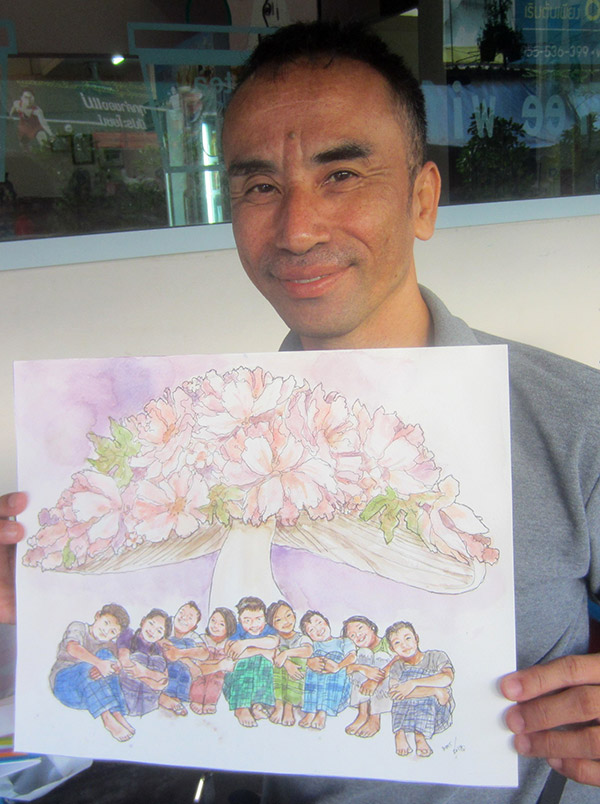
Maung Maung Tinn with his new book project
Volunteer Experiences: A process of adaptation and discovery
Note: Arriving in June for the beginning of the school year in Mae Sot, the volunteers plunge right into new and challenging situations, all part of their own learning. Two months into their experience, here are some of their observations.
Adapting to Life in Mae Sot
By Mari-Ann Burrows, 2019 Volunteer
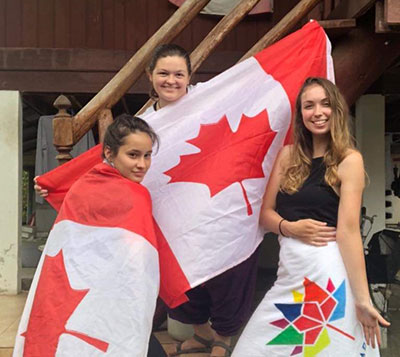
Celebrating Canada Day in Mae Sot
It has been sixty-three days since I left home, and there are just over one hundred and nineteen days left in my time here in Mae Sot. So far, I have not particularly had ‘the most amazing life-changing experience’ I imagined before coming, but that’s when I look only at the surface because in reality, I’ve already grown a lot. There is no way sixty-three days ago, I would have caught myself washing my hair with a bucket and living in a room with ants, lizards and X amount of other critters.
Life here is so different, but eventually, I have fallen into a routine, and it does not feel so different from home. Being a ‘teacher’, even if only a volunteer, I believe I should still hold myself to a certain standard. I dress appropriately. I wear long pants, long sleeve t-shirts most days and attire that is respectable for the culture here. My adorable students call me “beautiful” so I must be doing something right.
I meet with grades 3 and 6 at Hsa Mu Htaw Learning Centre and grades 6, 7 and 9 at Parami Learning Centre several days each week. My students, no matter which grade they are in, all make me feel happy, warm and welcome. It is amazing to see how some of these children who have so little can be so generous, happy and eager to learn compared to at home where children cry over losing something as simple as their tablet privileges or even a little game. It is heartwarming to see children who are still excited to play games outdoors and whether they win or lose, are simply excited to have the opportunity to learn from foreign Canadian college and university students.
Mae Sot itself is not the typical vacation destination, but it is beautiful just the same and upon looking harder, is filled with so many amazing people and things to do. People like Daw Htet Htet Aung, the headmistress at Hsa Mu Htaw, is such a kind and caring woman who looks like she would never hurt a fly and cares so much about everyone. The school is her home, and all the students are like her grandchildren. I’ve had the great opportunity to visit Hsa Mu Htaw on a few of my days off, to meet and play games with the students who board there. I live in the district of Baan Nua, and so do many of my students from both schools. Whether I am walking or biking to the market or to another school or coming home after school, I see my students in the street, and it’s so nice to hear, “Hi teacher Mary. How are you? We miss you.”
Since my arrival, I have had a lot of personal difficulties. Some volunteers come here for 6 months and never get sick and have an amazing experience, but in the two months I’ve been here, I’ve experienced food poisoning, a sun allergy and an infectious mosquito borne disease called chikungunya, along with being homesick. I am used to going away from home every summer, but being so far away from home for so long is a first for me. There is much to learn: paying bills, keeping track of the project’s money, keeping track of my own money, keeping the house clean… I know these seem like normal tasks that most students, especially at my age, have to learn to do, but they can prove to be a bit more difficult than normal in Mae Sot (especially cleaning, given the little critters that share our space….).
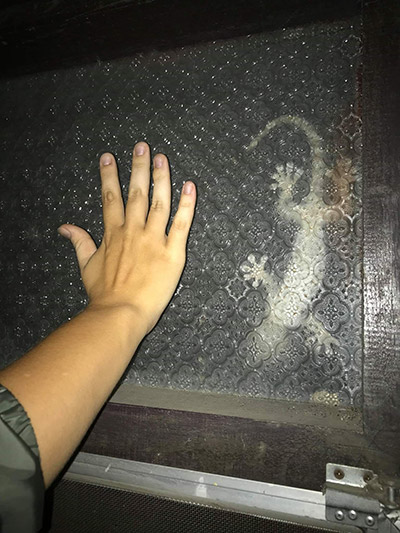
Mari Ann’s hand next to one of the critters
Then there is getting used to the different currency and exchange rate. I felt a little rich at first when I first received my monthly allowance of 3750 baht (about $160). It sounded like a huge amount, and it is very generous considering some of the teachers who work at the migrant learning centers receive less if there is not enough money that month in the school’s funds. However, it has to go far and needs managing.
Food also presented a lot of challenges during our first weeks in Mae Sot because I couldn’t read Thai so I did not know what was on the menus. Finding my way around to restaurants recommended by past volunteers or even finding the local night market was tricky. We ate a lot of RICE! Rice, meat on a stick from a street vendor and microwave noodles from the closest 7/11 are typical at the beginning. For the first couple weeks, chicken fried rice was my go-to supper probably four to five nights a week. Now that we’ve found our way around and our palettes are more adventurous, we probably only have western food once every three weeks. My personal favorite Thai dish is Khao Soi which is a coconut milk curry soup with noodles and a boiled egg, not spicy but still with a little spice.
I know that my journey here is not yet over, but two things I know for certain: One is that I underestimated the number of ways rice can be used. The second is that I will never forget this incredible opportunity that I have been given by being chosen by the Mae Sot Education Project to come here and make all these amazing memories, memories which will make such a difference in my own life and hopefully, in the lives of others too.
Just Imagine – an invitation to picture yourself in a very different place
by Anne-Constance Blanchette, 2019 Volunteer
Dear reader,
I would like for you to imagine yourself in this situation: You leave the volunteer house at 8:20 to bike to school in the town of Mae Sot. Everyone in town is up and working, merchants behind their stands selling food. You smell some really good southern Asian food and sometimes some odours you try not to inhale too much. The streets are packed with people on their way to places, and the horns of cars and motorcycles surround you.
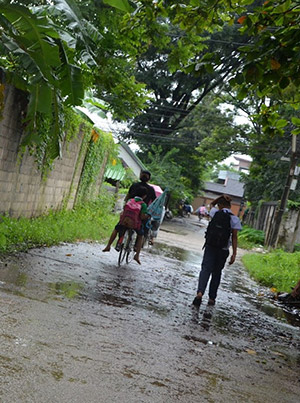
The road to the school – in the rain
As you continue cycling towards the primary learning centre, Pyo Khinn, you start to realise you are in a completely different part of town. There are fewer stores, and food stands. People are dressed differently, and many stare at you while you bike. You start to wonder what they might be thinking of you: “What is this person doing in this neighbourhood?” You cross the main road easily because there are not a lot of cars, and make your way to Pyo Khinn. The alleys are narrow, and every intersection is filled with trash. You pass a tiny little field with a cow that you’ve noticed is always attached to a pole. You bike very slowly because the streets are filled with water, and if you do not, the water will splash all over your pants and shoes. The sewer and irrigation system do not seem to work well here as the streets are always flooded. Inhabitants of this part of town walk barefoot in the water holding up their skirts and pants. Roosters and chickens are running all over, and mothers with their young children are sitting in front of their houses and look at you biking through the water. There’s a woman already working. She has big bags filled with plastic bottles that she dumps all over her front steps, and then she selects some of them to put in new bags on a trolley.
You continue biking until you have arrived at Pyo Khinn. On the wall, a mural is inscribed “Pyo Khinn Migrant Learning Center”. The students open a big blue gate for you and take your bag off your hands and store your bike in the crowded area where the students are currently having an assembly. They place your bag on a table. They smile and are excited to see you today. Next to the table a student fetches you a chair so you can rest. The headmaster is talking to them in Burmese; all you can do is observe. You notice that some of the children wear clothes that were most likely passed on from their older siblings as their shirts, pants, or skirts are too big for them. Others wear pants and skirts that are not zipped because they are too small for them. They look tired yet still pay attention to the words of the headmaster. It starts to rain, and the sound of the rain on the tin roof makes the headmaster inaudible so he talks louder. Then the assembly is over, and it is your turn to yell over the sound of the rain. The main building at the school is small and crowded. There are rice bags in classrooms and furniture stacked against the walls. There are four other classes going on in the same small building; meter long walls separate the classes, but they are not enough to reduce the overall noise.
Even if the neighborhood gives the administration a hard time to provide education, the students still appreciate a center where they can learn. At the end of the day, to have a school there needs to be a teacher and students. Pyo Khinn is situated in the Muslim part of town. These are the least lucky migrants; they are the poorest and have the most difficult backgrounds. Yet the students are always excited when you come to teach them. Their faces make you remember why you came to Mae Sot in the first place, to make a change in these students’ lives.
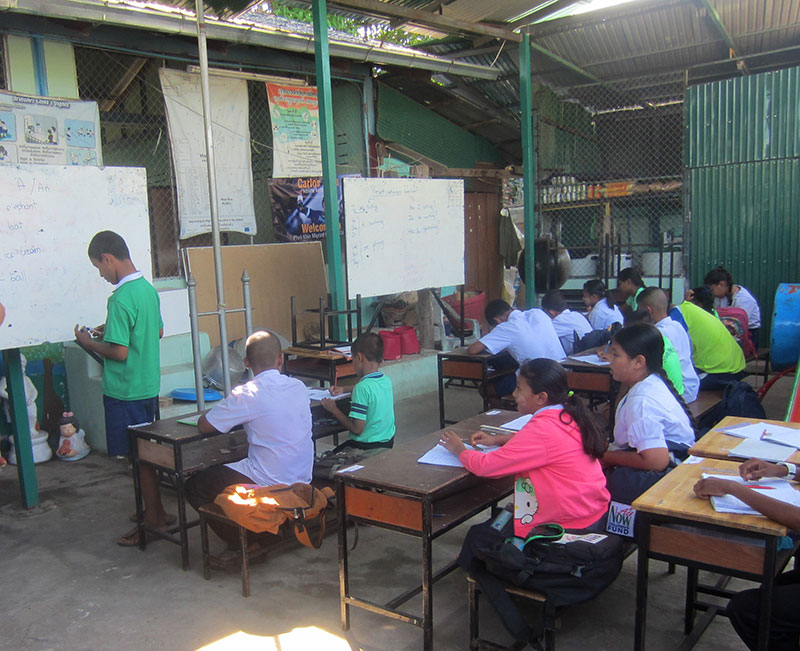
A classroom at Pyo Khinn Learning Centre
Knowledge – Seeing it in a new way
Also by Anne-Constance Blanchette, 2019 Volunteer
Teaching is the act of passing on knowledge. Embarking on this journey, I came knowing little about teaching itself, but now I truly understand the impact that knowledge has on people. I owe this realization to the grade 11 and 12 students I have met at the Hsa Thoo Lei migrant learning centre where I have been blessed with the most inspiring students. I have recently figured out that these students are teaching me just as much as I am teaching them.
They come from backgrounds that go against all odds, yet they still have aspirations and dreams they wish to achieve. “I want to be a photographer”, “I want to be a teacher”, or “I want to be a Karen Leader” are some of the ‘professions’ they are aiming for. Then there are some students who simply say, “I hope to go to university”. This phrase really struck me. Back home university goes without saying. Students apply and then go. Yet as migrants on this side of the world, they lack the resources to help guide them, and they are financially unable to attend or even apply to university. Many students in our part of the world take education for granted, and I am guilty of waiting for the clock to run off in my courses so I can go home. For these students, education is the one option that keeps them out of harsh labour and gives them the potential to experience a prosperous life.
Being able to be part of their road to success makes me realise how lucky I am to be here volunteering with such a bright group of young adults. They give a new meaning to the word ‘determination’, that even if you have had it hard in the past, that should not, nor should you let that, determine your future.
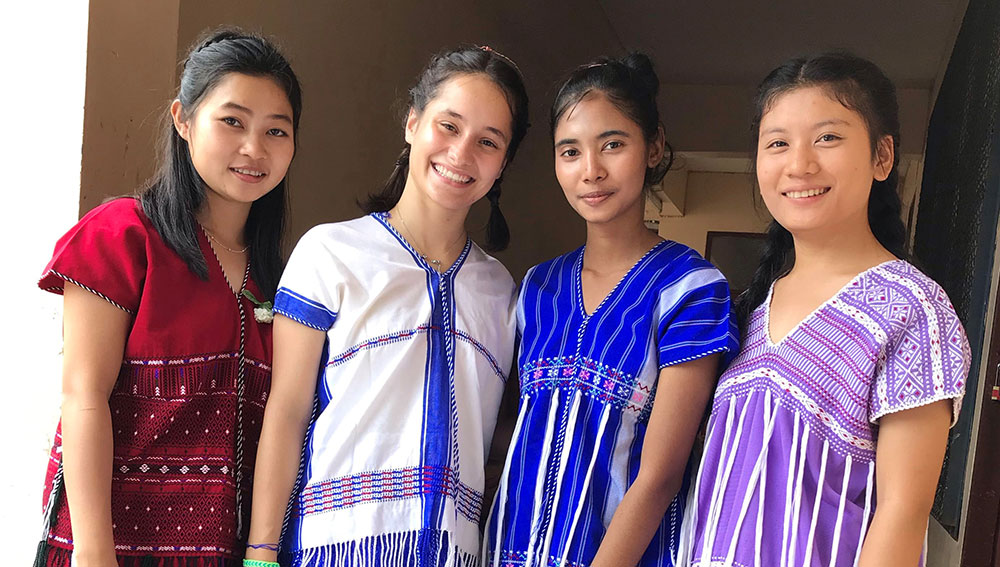
Anne-Constance celebrates a Karen ‘wrist-tying’ festival with students
A Volunteer’s Task: Building confidence while reconciling dreams with realities
By Virginie Levesque, 2019 Volunteer
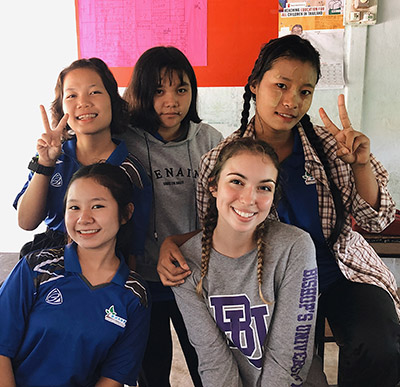
Virginie with students
At BHSOH Learning Centre, I have encountered many students who have dreams of becoming nurses, doctors, businessmen and who hope to go to well known universities all around the world. In fact, it is really hard for migrant students in Mae Sot to pursue a higher education. Even if they do graduate and pass the GED exam, it is impossible to assure that they will get a scholarship or any help towards studying their ‘dream career’. Knowing this, I thought it was important for me to help them reflect on how to love themselves because, even if their lives don’t go as planned, they can still always achieve something good if they believe in themselves.
So one day, I did an activity with my grade 12 students on ‘Confidence and How To Love Yourself’. The goal of this activity was to show them that it is so important to believe in themselves. To introduce the subject, we listened to a very interesting podcast from Paul Chek, a well-known speaker and expert on the subject. The podcast had the goal of explaining why it is important to love ourselves. As the recording was playing, I was incredibly impressed by the interest that the students were showing. They asked me to listen to it another time and then another time again.
We then proceeded to talk about it all together. At the end of a long discussion, I had them write a short paragraph about why they think it’s important to love themselves. Here are some short quotes from them to hopefully inspire anyone who will read this:
“You need to learn how to love yourself before you can love others, or else, you won’t know how to love the right way.”
“Loving yourself first is important because at the end of the day, no matter what, you always and maybe only have yourself.”
“You need to love yourself as much as you love the people around you, that’s how you keep balance.”
“You should love yourself because you are the only you ever; you are the only one that is lucky enough to experience life in your body.”
Each student had a different way of seeing and interpreting the subject.
I also asked them to share their future goals with me, which is when I found out that almost all of them are planning, or at least hoping, to go to university. At BHSOH, the school headmaster often recruits previous students to help with administration. Many of them are happily taking my English class, hoping to keep improving. One of these young men told me about how he wished to go to university but wasn’t able to get a scholarship. After talking with him for a while, we discovered together how much he enjoyed photography. We came up with the idea of Virginie with students a coffee shop where he could also give photography classes. He then got really excited about this idea and began to imagine a future. Though the goal might seem too big, it was a great way for him to have a goal to work towards, given the circumstances.
I am most definitely looking forward to creating more activities to encourage my students to reflect on how important it is for them to believe in themselves and to realize that, no matter what, they can still achieve good things in life.
Gallery
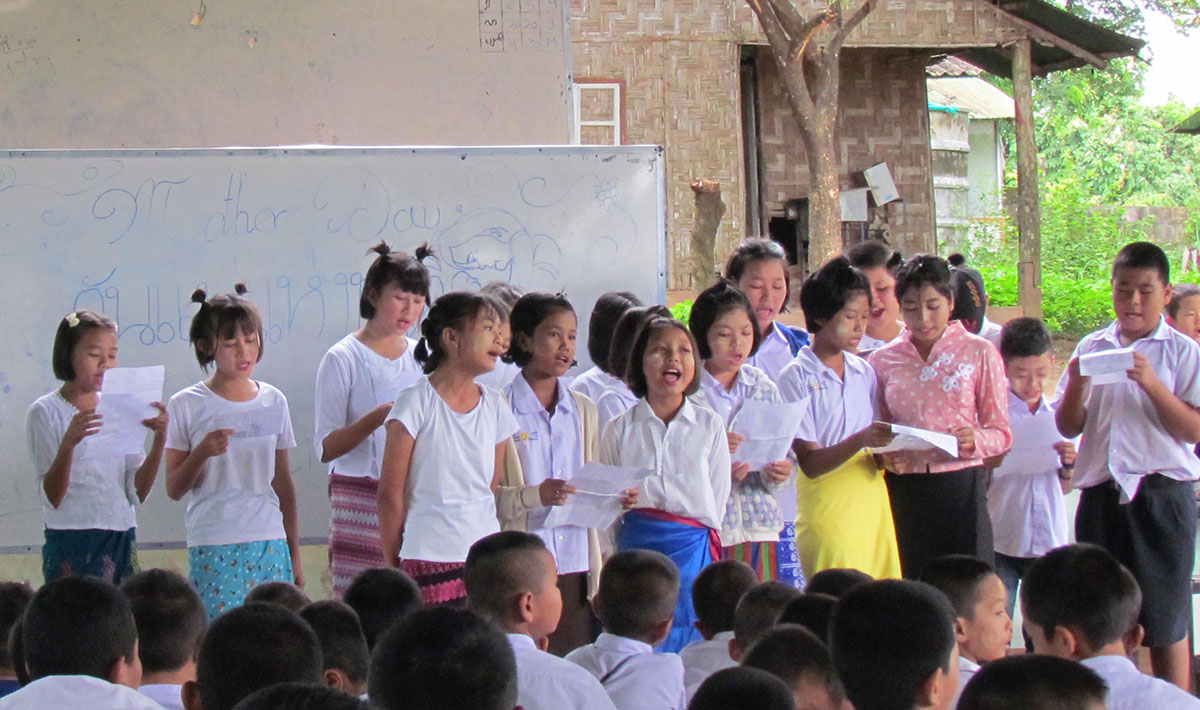
Children at Parami School celebrate Mother’s Day.
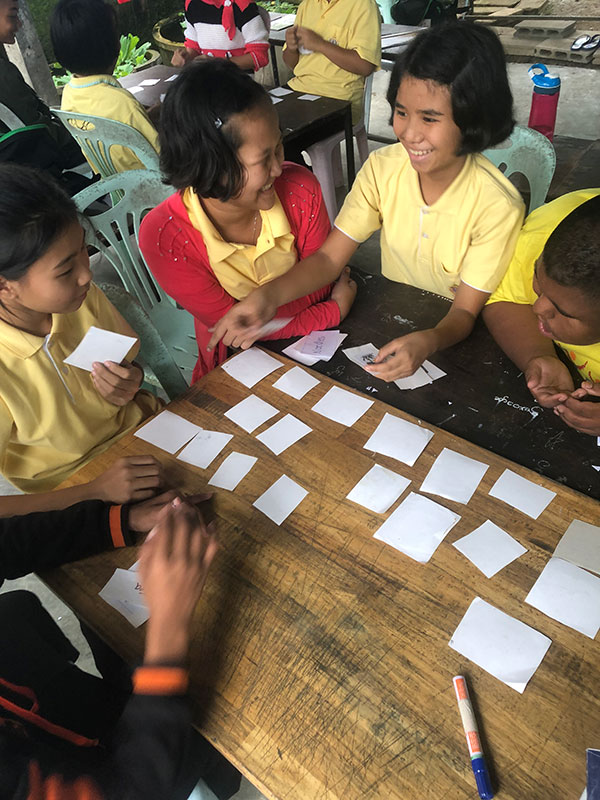
Hle Bee school children play a game.
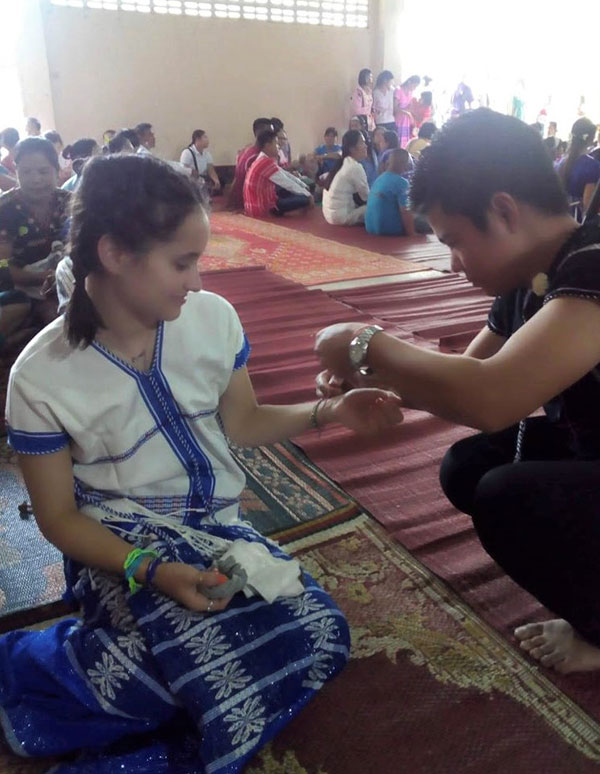
Wrist-tying ceremony.
Who we are and what we do
The Mae Sot Education Project (MSEP) is a community project based on the campus of Bishop’s University and Champlain College – Lennoxville in Sherbrooke, Quebec. Since 2004, we have provided assistance to six schools (officially called migrant learning centres or MLCs) for migrant and refugee youth from Burma/Myanmar whose access to education depends on support from the international community. In recent years we have also worked with other MLCs. Each year we select a group of young people from our campus to go to Mae Sot for six months. While there, they provide practical assistance to teachers and enrichment activities for children in the schools. They learn about the situation of displacement experienced by the Burmese people in Thailand as well as about the challenges for the Thai community in coping with a large population of refugees and migrants. Finally, they share their experience with Canadians. Over the last 14 years, MSEP has delivered over $126,000 in funding assistance (excluding two substantial grants given through specific donations) and as of June 2017, will have sent 56 volunteers to assist the migrant education community in Mae Sot.
The Project Committee is made up of members of the community, faculty from Bishop’s and Champlain, and former youth volunteers with the project. Currently, members are: Felix Duplessis Marcotte (2016 volunteer), Judy Keenan, Laurence Michaud (2015 volunteer), Graham Moodie, Mary Purkey, Garry Retzleff, Barbara Rowell (2005 volunteer) and Calila Tardif (2016 volunteer).
Contributions to the project are always welcome and tax receipts are issued. To make a donation electronically, go to our Donate Now page and follow instructions for donating through the Bishop’s University Foundation online or by cheque.
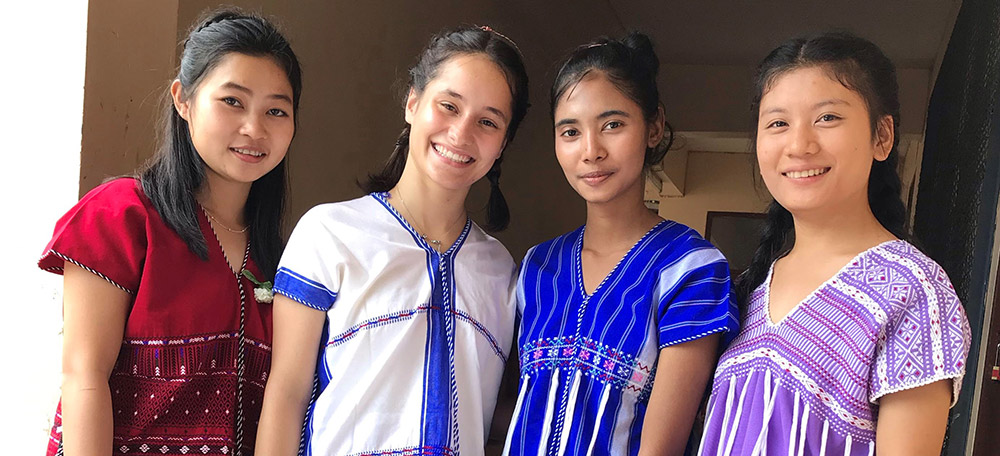
Recent Comments